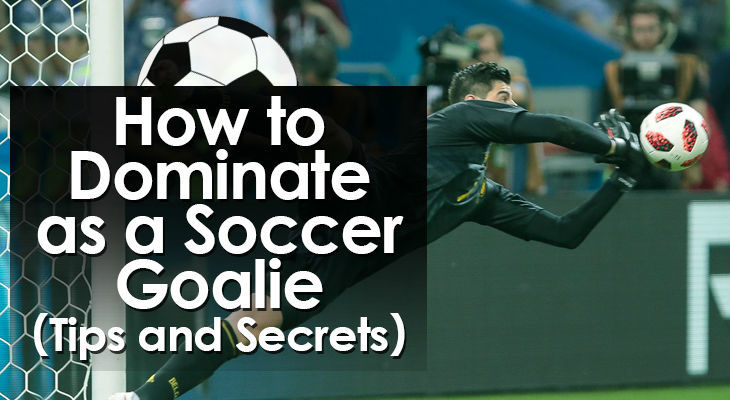What is a Goalie in Soccer? (Full Position Guide)
A goalkeeper - often referred to as a goalie or keeper - is the last line of defense on a soccer field.
Teams require goalies to do everything possible to prevent the opponent from scoring.
It’s undoubtedly the most unique position in all of soccer, with leagues holding them to a different ruleset than outfield players.
They’re the only players allowed to handle the ball and they even wear a different color kit than the rest of the team.
What’s more, playing as a goalie requires a certain set of athletic attributes that essentially come down to genetics.
For example: In today’s game, it’s rare to see a goalkeeper under 6 feet 2 inches.
In this guide, I break down all the elements of a modern goalkeeper and outline the responsibilities, traits, and tips you need to excel.
What is a Goalie in Soccer?
A soccer goalie is a special position for a tall, agile, and brave player who’s willing to put their body on the line to stop the opposing team from scoring.
Goalies are the only players allowed to use their hands (when they’re inside their own penalty box), giving them full use of their bodies to stop shots.
The primary objective of a soccer goalie is a simple one:
Stop the ball from going into the back of the net.
From game to game, goalies use different techniques and parts of the body to make saves.
Goalies should have fast reflexes, good instincts, excellent agility, and dexterity to keep clean sheets throughout games.
In the past goalkeepers didn't have any offensive responsibilities. But today, they have far more nuanced roles and most teams play with keepers who are skilled with the ball at their feet.
This falls in line with the build-from-the-back, possession-based, and press-resistant strategies that modern teams use.
In addition to being elite shot-stoppers, modern goalies must be good at passers, comfortable receiving passes, and willing to come off their line to get involved.
Previous generations would have referred to this style of goalie as a sweeper keeper.
But nowadays, this archetype is fast becoming the standard.
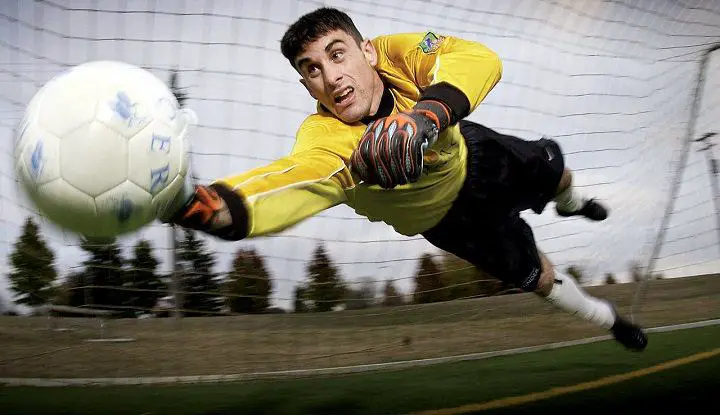
Position of a Soccer Goalie
This might surprise you, but a goalie's position can vary significantly throughout a game.
Even more so when the coach sets up a specific tactic or strategy, such as a high defensive line.
When the ball is in the opponent’s half of the field, the goalie is usually off their line, hovering around the edge of the penalty area or sometimes even further forward.
Taking up this position allows them to react quickly to a through ball or over-the-top pass, sweeping and clearing the ball as needed.
When the opponents have possession, the goalie must be careful not to venture too far off their line or they run the risk of being lobbed from distance.
Once the ball enters the final third of their half, the goalie typically retreats inside their box and gets into position to block a shot or claim a cross.
If their team has possession, the goalie usually comes to the edge of their penalty area, or beyond, to make themselves available for a pass.
Manchester City and Liverpool’s goalkeepers (Ederson and Alisson) often step out even farther as they each possess playmaking skills that even some outfielders would envy.
Despite what you might think, goalies in soccer spend little to no time on their line.
Even when opposition strikers have the ball in dangerous positions within the penalty box, the goalie comes off the line to close the shooting angle and make it difficult to shoot past them.
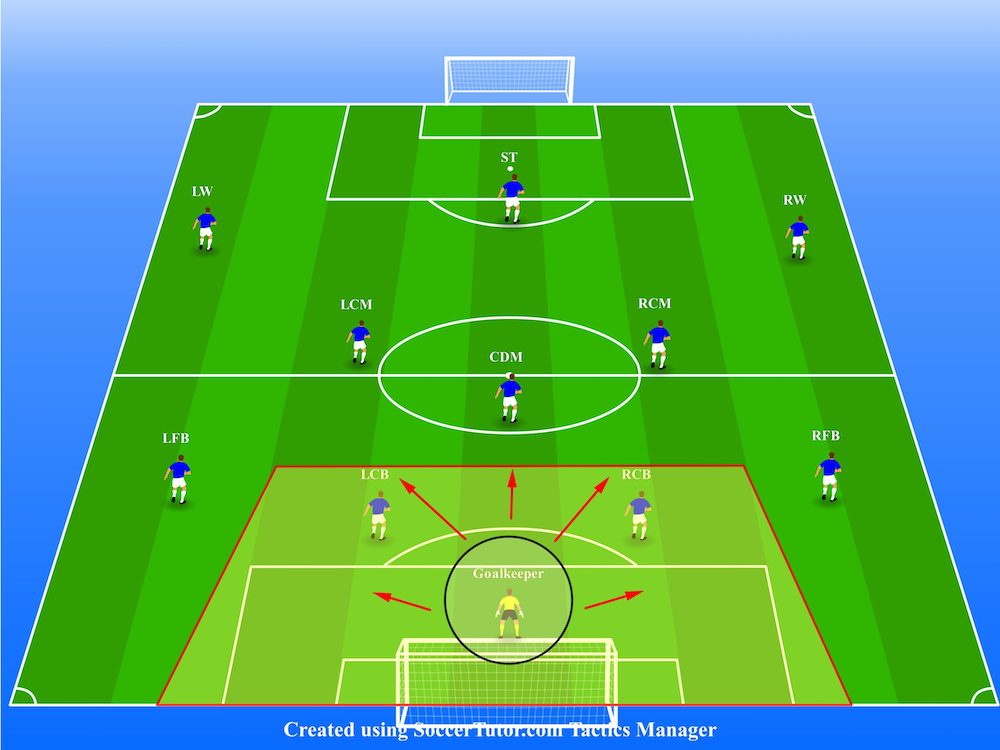
What Does a Soccer Goalie Do?
I’ve already mentioned how a goalie’s role is a straightforward one, particularly from a defensive standpoint.
While goalie instructions may not look complicated, many people say that goalie is the hardest position in soccer.
There's no margin for error, with practically every mistake leading to a goalscoring opportunity for the other team.
Below, I break down the roles of a goalkeeper in detail, giving you a better scope of their responsibilities.
Goalie's Role In Defense
#1 - Stop Shots
Shot stopping is the first and foremost priority of a soccer goalie.
They make use of everything the can -- their athleticism, reflexes, and frame -- to protect the goal.
Goalies make a wide variety of saves in each game.
From simple chest catches to fingertip flicks around the post, and from low diving stretches to “starfish” blocks.
Keepers should not only be competent shot-stoppers, but they must also know when a shot requires a certain type of save.
For example, in a crowded penalty box, it’s often safer to parry the ball away from the goal or out for a corner -- rather than risk fumbling a catch to leave an easy rebound for an incoming striker.
Or, a goalie might decide to save a low shot with their feet instead of dropping low with their hands to collect the ball, averting the risk of it sliding under their body.
Some goalies are great natural shot stoppers.
However, to develop consistently good decision-making in live game scenarios, they must practice a range of techniques and identify their strong points for different types of shots.
In addition to stopping one shot, a keeper must frequently think about the next one, ensuring they’re in the right position to make a double or even triple save.
Large, strong hands and healthy joints help goalies keep out powerful shots from top professionals without getting injured.
#2 - Claim Crosses and Command the Box
The penalty box is sacred ground for a goalie.
It’s their responsibility to command this area and rule it with an iron glove.
This means coming for high crosses and using their advantage to catch or punch them away.
That said, a goalie can’t claim every cross that comes their way, or else they’ll end up in “no man’s land” and get rightly punished.
When they can’t deal with a cross themselves, the goalie must instruct their defenders on what to do.
For example:
If the defender at the front post has a striker coming at them at speed, the keeper must warn the defender to get the cross away quickly.
Or, if there is a late runner to the back post that a fullback isn’t aware of, the keeper should instruct them to deal with it, rather than let it run.
Clear communication and a strong understanding of the backline are essential for being a successful goalie at the top level.
#3 - Play the Sweeper-Keeper Role
Most modern goalies assume the role of a sweeper-keeper.
Essentially, this means positioning themselves well off their line so they can rush outside of their penalty box to intercept long passes or loose balls.
This is one of the most difficult responsibilities of a goalkeeper.
It requires focus and concentration for 90 minutes, excellent reading of the game, anticipation, and timing.
One slip-up can leave the goal totally exposed and cause a rather embarrassing moment for the goalie, so they must be assured in their decision-making.
Effective sweeper-keepers, like Manuel Neuer, are effectively extra defenders for their teams, allowing them to play with high lines which helps suffocate the opposition team.
#4 - Lead from the Back
The soccer goalie has a better view of the pitch than anyone.
With the entire field ahead of them, it’s imperative that they lead from the back. Offering positional instructions, encouragement, and general information to teammates.
Soccer goalies should consider themselves an extension of the backline -- so it’s vital that the entire unit is in sync.
Often isolated figures camped in their own half of the field, frequently communicating with teammates is also a great way for a goalie to keep focused.
This is especially true for goalkeepers playing for top teams.
Teams at the highest level may only really need to call upon a goalie two or three times in a game -- but when they do, goalkeepers must deliver.
Lower-tier teams are likely to concede higher volumes of chances, giving their goalies enough opportunities to make an impact.
Goalie's Role In Attack
#5 - Take Kicks
Goalies aren't only responsible for taking goal kicks, but also take control over many free kicks inside their half of the field.
Since they spend their entire careers punting long balls up the field, they're often great at delivering direct balls toward the opposition penalty area.
Not to mention that having the goalie take free kicks enables the backline to maintain its structure, ensuring they’re in position if they end up turning the ball over.
Outfield players taking deep free kicks essentially forces the defensive line to drop back, making it easier for the opposing team to press.
#6 - Recycle Possession
In keeping with the sweeper-keeper theme, modern goalies are often heavily involved in the early stages of build-up play.
While they may not be as influential as a ball-playing center back or playmaking midfielder...
Goalies can help establish possessional dominance by making themselves available for relief passes.
Rather than playing a risky pass or knocking it long, a defender can simply roll the ball back to the goalie to restart the build-up.
Highly talented goalies can use their striking technique to switch the point of attack or play more threatening passes forward.
We’re seeing many top teams invest in technically gifted goalies who can contribute to build-up play and make an impact with the ball at their feet.
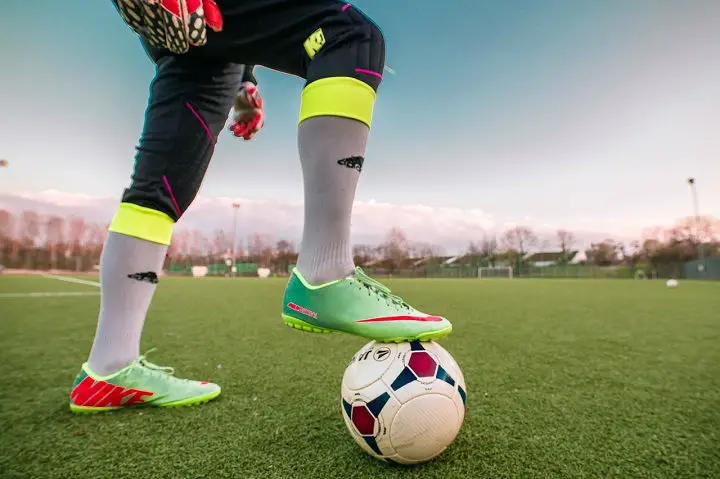
6 Key Traits of a Goalie
If you want to take your game to the next level and learn to dominate as a soccer goalie, it’s important to know what the key traits of a top-stopper are.
Below, I’ve outlined the most common attributes of a modern professional goalie.
a. Agility and Reflexes
Great goalies have the athleticism and reflexes to make jaw-dropping saves.
Elite-level agility can be the difference between winning and losing in a big game.
Keepers rely on having cat-like reflexes to stop a point-blank shot are get their fingertips to a deflected ball.
Agility and reflexes are also needed to move around the box and reposition quickly.
As we discussed, a goalie’s job involves far more than getting in the way of the occasional shot.
They must be nimble and agile to react to loose balls or close down a striker.
b. Physicality and Commanding Presence in the Box
Goalkeepers need to be physically strong to compete in crowded penalty boxes and contest crosses against powerful strikers.
Although goalies are frequently given “soft” free kicks for contact with an opponent, decisions don’t always go their way.
A keeper can’t rely on the referee to command their box effectively.
Physicality and a commanding presence in the box help the defense assert dominance and make strikers think twice about competing for a 50/50.
c. Good Technical Skills
Modern goalkeepers are technicians with the ball at their feet.
In addition to having solid goalkeeping fundamentals, they must be confident on the ball and capable of receiving and making passes, even when getting closed down.
The main on-the-all skills a top goalie should have are a good first touch and perfect striking technique.
These attributes are typically enough to ensure competency in the backline during the build-up phases of play.
d. Safe Hands
This is an obvious one, but it shouldn’t be understated.
All goalies must have safe and reliable hands for all types of occasions.
During goalkeeper training, they must work on catching the ball in a range of scenarios -- like collecting high crosses from set pieces, getting down to intercept low-driven crosses, and holding on to powerful shots when a striker is close by.
That said, a goalie should also know their weaknesses.
If a shot is carrying too much pace, they must be aware enough to parry the ball to safety, away from incoming opponents.
Having a goalie with a safe pair of hands is also beneficial for defenders as they know they can rely on their number 1 to deal with balls inside the penalty area.
e. Excellent Reading of the Game
Top-tier goalies are excellent readers of the game.
They rely on their soccer IQ to anticipate where the ball will go, which tells them where to position themselves.
This can mean occupying an advanced position in anticipation of a long pass or it could involve stepping slightly off the line to get ready for a cross.
Being a good reader of the game also benefits teammates as the goalie can communicate imminent dangers or bark out instructions where they see fit.
f. Bravery
It takes a special breed of player to voluntarily get in the way of powerful shots from opponents.
The goalkeeper position is one that requires bravery and sacrifice.
With little regard for their own safety, a great goalie is always willing to throw themselves at the opposition’s feet and put their body on the line to prevent them from scoring.
Whether they’re diving at full stretch and risking slamming into the post or rising above other players to punch the ball away, courage in the face of potential harm is needed.
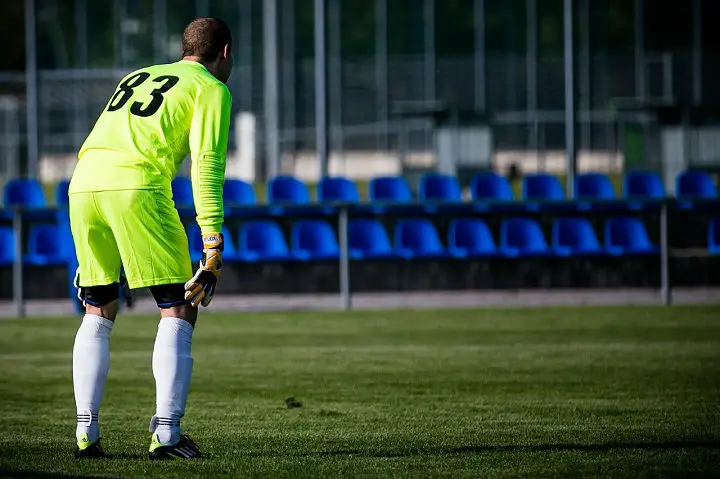
Best Goalies of All Time
They say that all goalkeepers are a little bit mad.
Often lauded as larger-than-life characters, everyone has their favorite stopper, relating to moments of heroics for their teams.
However, most will agree that some goalies have a pedigree that separates them from the rest of the bunch.
With that, here are my top 10 goalies of all time.
- Lev Yashin
- Gianluigi Buffon
- Peter Schmeichel
- Gordon Banks
- Oliver Khan
- Petr Čech
- Manuel Neuer
- Edwin van der Sar
- Iker Casillas
- Dino Zoff
5 Bonus Tips for Goalies
As a position continues to grow in influence, up-and-coming goalies should stay on top of their training regimen.
If you’re looking to improve your overall skill set and create an impact on your team, there are a few key areas worth focusing on.
Here are 5 pro tips that are sure to help you dominate as a soccer goalie.
Tip #1: Maintain Focus Through Communication
Goalkeepers often spend large periods of the game away from teammates and without the ball.
Yet still, they remain poised and ready to react at any moment.
To remain focus throughout the game, goalies should be in constant communication with the backline and other teammates.
This shouldn’t be aimless communication, however.
As a keeper, you should scan the field constantly to anticipate incoming attacks.
With a clear view of the backline, you should be in place to give good positional instructions to defenders.
Tip #2: Work on Distribution
As discussed, modern goalies must have a certain level of skill on the ball.
Distribution is the most important on-the-ball skill a keeper can have.
If you’re an up-and-comer, prioritize kicking practice in your spare time.
Work on long-distance goal kicks, medium-length accurate passes, as well as short-distance passes.
You should also practice kicking rolling and static balls, replicating in-game scenarios.
Tip #3: Don't Ignore Technical Skills
As well as practicing kicking, be sure to work on other techniques, like your first touch, footwork, and quick passing.
You can improve these parts of your game by taking part in outfielder drills during training or running drills in your backyard.
Either way, improving in these areas will make you a far more valuable asset to your team.
Tip #4: Practice Situational Training
As a goalkeeper, you must be ready for anything.
You never know when or how you’ll be in action during a game.
To ensure you’re primed to react at any given moment, make sure to practice situational training.
This can involve drilling defensive corners, free kicks, crosses, penalties, and 1v1s.
The more you practice situational training, the better prepared you’ll be on match day.
Tip #5: Focus on Athleticism and Recovery
Goalkeepers need to make explosive movements in every game and training session.
Moreover, they put their bodies on the line to prevent the ball from going past them.
Diving, jumping, and rushing to close down opposing strikers are all powerful movements that take their toll on the body.
Goalies must stretch, work on their flexibility, and prioritize recovery to stay in shape throughout the season.
Otherwise, injuries can become a serious threat.
Conclusion
From diving bravely at the feet of strikers to tipping long shots over the bar and claiming crosses...
A great keeper can make their job look effortless.
But make no mistake, it’s a difficult position.
Still, if a goalie understands what they need to improve and they’re willing to work hard on their game, they can stand out as a great player.
At the end of the day, it’s up to you to decide if it’s worth the effort!

